While most of us catch largemouth bass between 1-5 pounds, trophy fish can reach shocking sizes. The world record stands at 22 pounds, 4 ounces since 1932! Female bass grow considerably larger than males, with southern waters producing bigger fish thanks to longer growing seasons. Food supply, water temperature, genetics, and habitat quality all influence how massive these freshwater giants can become. We’ve seen pre-spawn spring fish weigh 30% more than other seasons.
Record-Breaking Monsters: The Largest Bass Ever Caught
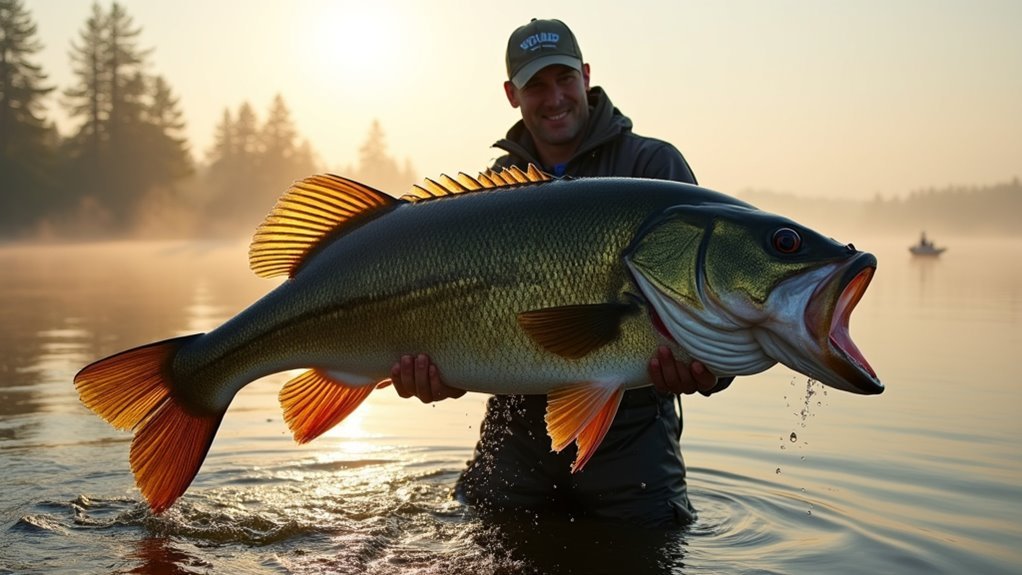
Two legendary bass stand above all others in the record books, and they’ve captured the imagination of anglers worldwide for generations. George Perry’s 22-pound, 4-ounce behemoth caught in 1932 held the solo title for nearly 80 years until Manabu Kurita tied the record with a 22-pound, 5-ounce giant from Japan’s Lake Biwa.
State records show impressive variations too. California boasts a whopping 21-pound, 12-ounce monster, while Alabama and South Carolina showcase 16-pounders. We’ve seen many 10+ pounders come in during tournaments, but these record-breakers remind us what’s possible when perfect conditions meet the right fish.
Average Size Expectations: What Most Anglers Actually Catch
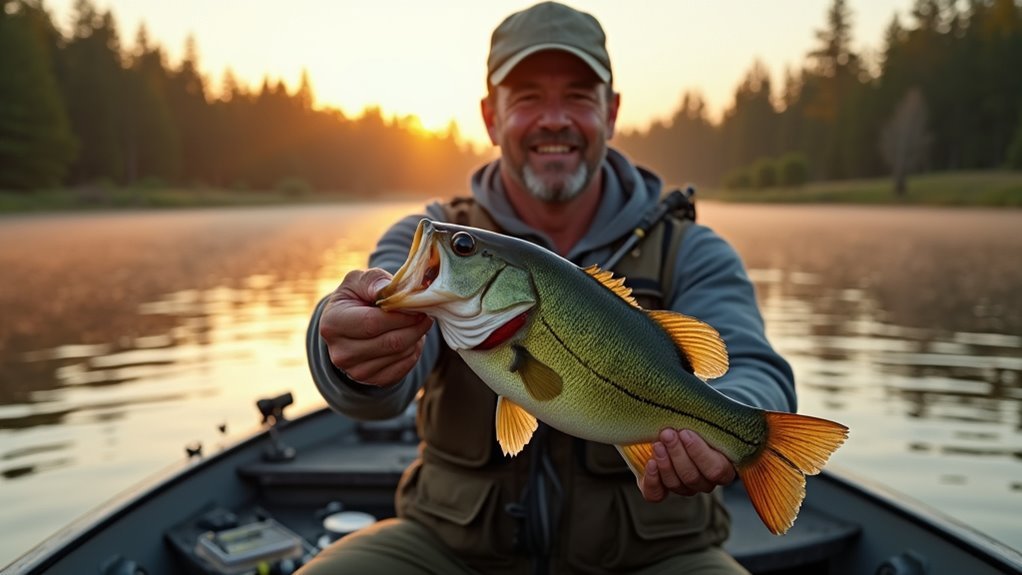
Most anglers won’t reel in record-breakers on a typical fishing day—and that’s perfectly okay. The average largemouth bass caught across America weighs between 1-5 pounds and measures around 15-20 inches. We’ve found these modest-sized fighters still deliver plenty of excitement!
- Male bass typically max out under 5 pounds
- Females grow larger, accounting for most trophy catches
- Warmer southern waters produce bigger bass than northern lakes
- Average lifespan ranges from 10-16 years
- Most anglers catch dozens of 2-pounders before landing a 5+ pounder
Remember when I hooked that chunky 4-pounder in Georgia? My buddy called it “average” there, but it would’ve been a prize catch back home!
Factors Influencing Bass Growth and Size Potential
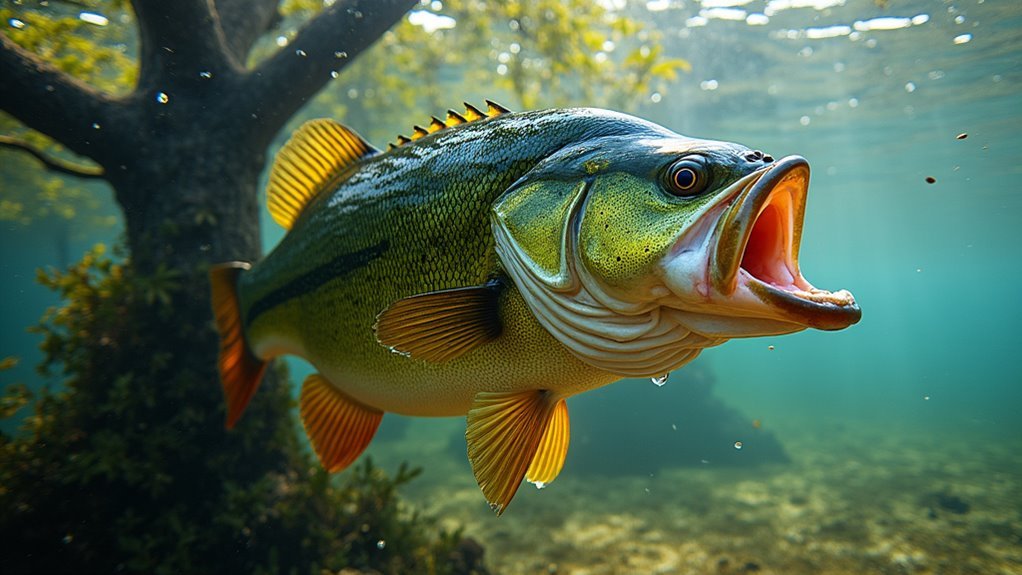
While catching those average-sized bass can be thrilling, you’ve probably wondered why some lakes produce monsters while others seem full of runts. It’s all about the perfect storm of conditions that leads to trophy bass.
| Factor | Impact on Growth | Time to Effect | Management Possibility |
|---|---|---|---|
| Food Supply | High | 1-2 Seasons | Moderate |
| Water Temperature | Medium-High | Immediate | Low |
| Genetics | Medium | Generations | High with stocking |
| Habitat Quality | High | 2-5 Years | High |
We’ve seen this firsthand at Lake Fork, where a combination of Florida strain genetics, ample forage, and protected spawning areas created a trophy factory. Water temperature is particularly essential—warmer southern waters typically produce larger bass than northern lakes.
Regional Variations: How Location Affects Bass Dimensions
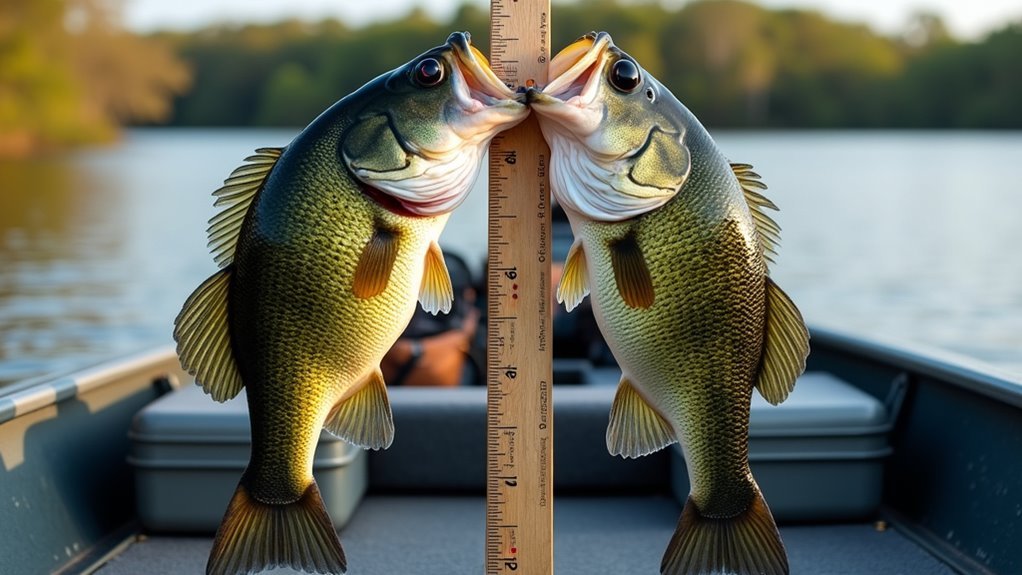
When you travel across different regions of the United States, you’ll notice that largemouth bass dimensions aren’t uniform everywhere. We’ve seen this firsthand during our fishing trips from Florida to Michigan.
Regional factors greatly impact how big these fish grow:
- Southern states like Florida and Texas produce monsters due to longer growing seasons
- Northern bass grow slower but can live longer
- California’s stocked lakes hold some of the biggest records
- Southeastern states benefit from warm water and abundant forage
- Urban lakes often surprise with hefty bass due to less fishing pressure
Water temperature is truly king—we’ve caught 5-pounders in January in Florida while our Minnesota lakes were frozen solid!
Proper Measuring Techniques for Accurate Length and Weight
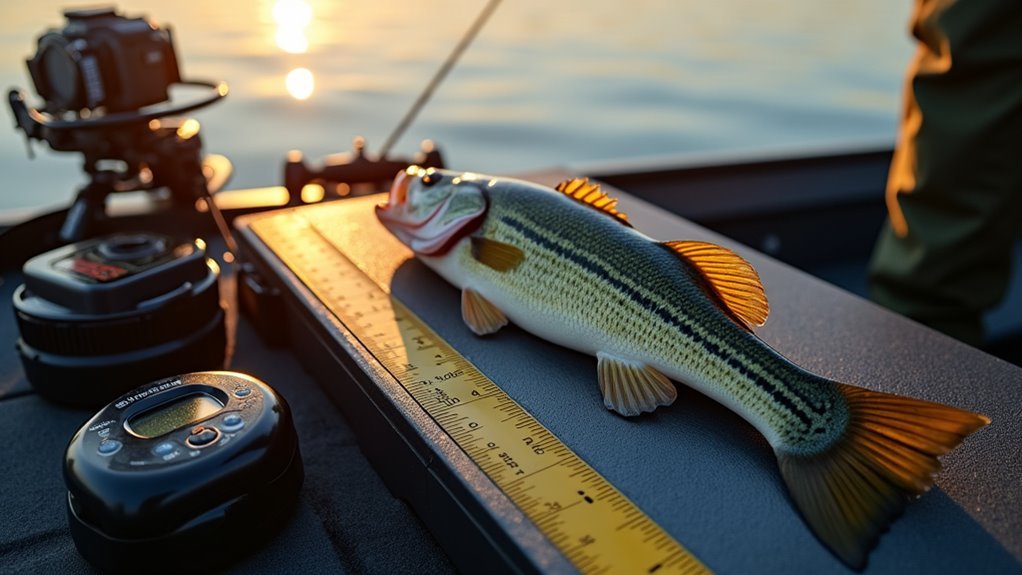
Knowing how big those regional bass truly are requires precise measurement techniques—something we’ve learned the hard way after decades on the water. For length, always measure from the tip of the lower jaw to the furthest point of the tail on a flat surface. We’ve seen countless anglers pinch tails or stretch fish, but honesty pays dividends in credibility!
For weight, sling scales work great for boat fishing, while lip grippers save you on unstable shores. Remember when my digital scale died mid-tournament? Always carry backup! Weighing immediately prevents water loss affecting the measurement—a mistake I’ve watched cost championships.
Seasonal Size Patterns: When to Find the Biggest Bass
The biggest bass of your fishing career often depends more on timing than location, regardless of what those fancy fishing magazines tell you. We’ve found that understanding seasonal patterns is your ticket to landing trophy-sized largemouths.
- Spring (pre-spawn): Bass are heaviest with eggs, often 20-30% larger
- Early summer: Post-spawn bass actively feed to recover weight
- Mid-summer: Look deep during hot days when big bass retreat to cooler zones
- Fall: Trophy hunters’ paradise as bass bulk up for winter
- Winter: Slowest metabolism, but the biggest fish still need to eat
Timing truly trumps location when pursuing those record-breakers.
Frequently Asked Questions
Can Bass Size Be Predicted by the Color of Water?
We can’t predict bass size by water color alone. While clearer water might offer better visibility, size depends on factors like food availability, temperature, and regional conditions.
Do Largemouth Bass Shrink When Removed From Water?
Yes, largemouth bass do shrink when removed from water. We’ve observed that they can lose about 2-3% of their weight due to dehydration, which affects measurement accuracy during tournaments.
How Does a Bass’s Age Affect Its Fighting Ability?
We’ve found that as bass age, their fighting ability peaks in middle age then gradually declines. Younger bass are faster but less powerful, while older ones fight with experience but tire quicker.
Can Certain Lure Colors Trigger Bigger Bass to Strike?
Yes, certain colors can trigger bigger bass strikes. We’ve found that natural colors work best in clear water, while bright colors excel in murky conditions where they’re more visible to large bass.
Do Artificially Stocked Bass Grow Differently Than Native Populations?
Yes, stocked bass often grow differently than natives. We’ve observed they typically grow faster initially due to hatchery diets, but may not reach the same maximum size under natural conditions.
Conclusion
We’ve explored the magnificent world of largemouth bass, from record-shattering monsters to the everyday catches that keep us coming back. Understanding their growth factors and regional differences has made us better anglers. Next time you’re on the water, remember that proper measuring techniques and seasonal patterns are your friends. The bass out there are growing so fast, they’re practically wearing out their scales! We’ll see you on the water, friends.